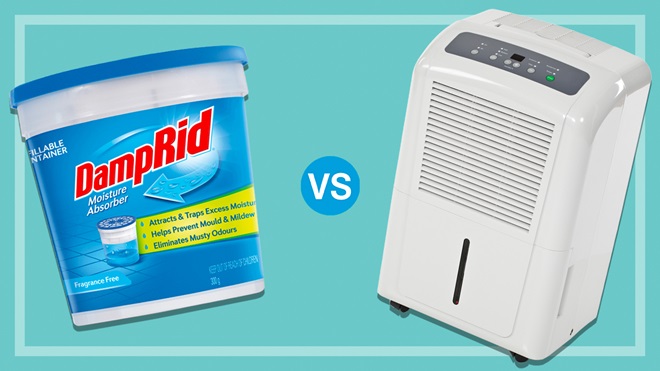As the days grow longer and warmer, spring brings with it not only the joy of fresh blooms but often a surge in humidity and dampness in our homes, especially when combined with seasonal rain and storms.
This is not great news if your home is susceptible to unsightly and unhealthy mould or damp problems.
Dehumidifiers reduce condensation and limit the impacts of persistent dampness and mould, but they can also be expensive. The models we've reviewed cost anywhere from $200 up to over $1699, and there's also the electricity costs to factor in.
If your home has a damp issue but you can't quite stretch to spending hundreds of dollars on a dehumidifying appliance, you may have considered picking up a moisture-absorbing product such as DampRid from your local supermarket or hardware for less than ten bucks.
But how effective is DampRid in dealing with dampness? We put it to the test by measuring its moisture-absorbing capabilities against some dehumidifier appliances. Here's what we found.
What is DampRid?
DampRid is a moisture absorber that uses calcium chloride crystals to absorb excess moisture in the air. The liquid that collects in the DampRid container can be disposed of by either flushing down the toilet or down your sink.
Other brands of moisture-absorbing products that you'll find in supermarkets and hardware stores include Hippo and DampFree. For the purposes of this comparison, however, we looked specifically at DampRid.
DampRid comes in refillable and disposable containers and claims to last between 45 days to six months, depending on the product type.
Does DampRid work?
Yes. CHOICE household products expert Chris Barnes says: "We put a DampRid container in a sealed test chamber about the size of a closet with 80% humidity and a fan for air movement."
"Within three days, DampRid reduced humidity to 43% and collected almost half a cup of water."
Is DampRid as good as a dehumidifier?
No. Chris says: "Our testing found DampRid is nowhere near as rapid or effective as a good dehumidifier, but for its price, it is an option worth considering for low-level damp problems.
When we checked how DampRid compared in a mild 65% humidity test against all the currently available dehumidifiers in our review, we found:
- DampRid removed 2ml of water on average from the air per hour
- The worst dehumidifier in our review removed 113ml of water from the air per hour (however the worst we ever tested removed only 10ml per hour)
- The best dehumidifier removed a mighty 388ml of water from the air per hour
So if you're facing serious ongoing dampness problems, a good dehumidifier is a much better solution and investment.
When to use DampRid or a similar moisture-absorbing product
While the best dehumidifiers on the market will give you almost instant dehumidification, absorbing hundreds of grams of water in just an hour, DampRid can do the trick (albeit more slowly) in some cases for a fraction of the price.
"If you have low-level dampness in small or confined areas of your house, or just want to keep your closets dry, DampRid and equivalent products are not a bad solution. They are cheaper and they work, just at a slower pace," says Chris.
If you have low-level dampness in small or confined areas of your house, or just want to keep your closets dry, DampRid and equivalent products are not a bad solution
CHOICE expert Chris Barnes
However, for serious dehumidification in homes with severe mould and dampness, you'll need to consider your home's damp-proofing and ventilation, and/or buy a good-quality dehumidifier.
Is DampRid toxic?The active ingredient in DampRid is calcium chloride, a commonly used chemical in household products. The product should always be used following instructions and should not be ingested, inhaled or come into contact with eyes or skin as it can cause irritation.
It should also be placed out of the reach of children and pets. The product could become hazardous if used off-label (such as if people have prolonged or constant exposure to the product).
Tips for using moisture-absorbing products such as DampRid
- Moisture-absorbing products will not absorb standing water, only moisture from the air. If you need to extract water from a car or enclosed space, use a pump or wet-dry vacuum.
- Open doors, windows and vents to allow proper circulation and air flow.
- Use in conjunction with fans to speed up drying if possible (likely not suitable if you're using the moisture-absorbing product in an enclosed space such as a wardrobe).
- Moisture-absorbing products will need to be replaced more often in high-humidity conditions. Check regularly.
- Ensure you keep out of reach of children and pets, and avoid contact with eyes and skin.
We're on your side
For more than 60 years, we've been making a difference for Australian consumers. In that time, we've never taken ads or sponsorship.
Instead we're funded by members who value expert reviews and independent product testing.
With no self-interest behind our advice, you don't just buy smarter, you get the answers that you need.
You know without hesitation what's safe for you and your family. And our recent sunscreens test showed just how important it is to keep business claims in check.
So you'll never be alone when something goes wrong or a business treats you unfairly.
Learn more about CHOICE membership today
Stock images: Getty, unless otherwise stated.




